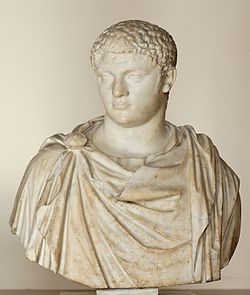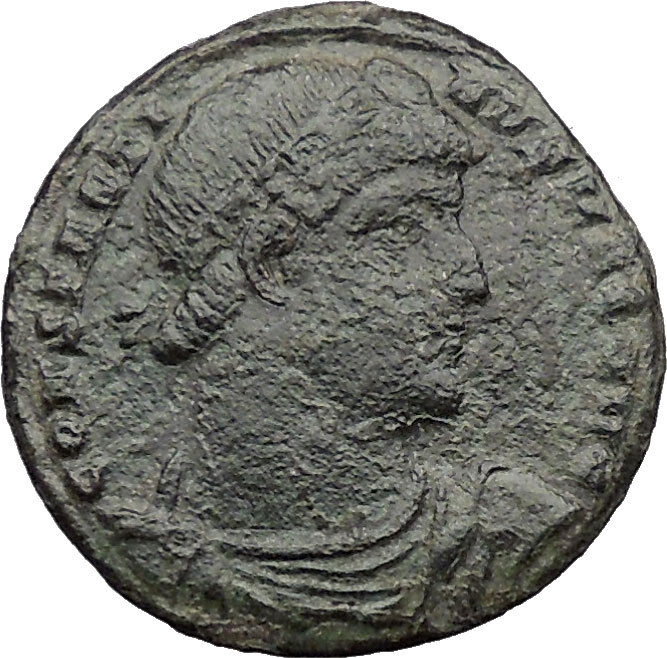|
Geta – Caesar: 198-209 A.D. and Roman Emperor: 209-211 A.D.
Geta as Caesar
Silver Denarius 19mm (2.72 grams) Struck at the mint of Rome mint, 200-202 A.D.
Reference: RIC 18; sear5 #7196; RSC 157.
. P SEPT GETA CAES PONT, draped bust right
PRINC IVVENTVTIS, Geta, in military dress, standing left with baton & sceptre, trophy behind.
A club (also known as cudgel, baton, truncheon, nightstick, or bludgeon) is among the simplest of all weapons. A club is essentially a short staff, or stick, usually made of wood, and wielded as a weapon since prehistoric times.
Most clubs are small enough to be swung in one hand although two-handed variants are known. Various kinds of clubs are used in martial arts and other specialized fields, including the law-enforcement baton . The military mace is a more sophisticated descendant of the club, typically made of metal and featuring a spiked, knobbed or flanged head attached to a haft.
You are bidding on the exact item pictured, provided with a Certificate of Authenticity and Lifetime Guarantee of Authenticity.
 A trophy is a reward for a specific achievement, and serves as recognition or evidence of merit. A tropaion (Latin: tropaeum), whence English “trophy” is an ancient Greek and later Roman monument set up to commemorate a victory over one’s foes. Typically this takes the shape of a tree, sometimes with a pair of arm-like branches (or, in later times, a pair of stakes set crosswise) upon which is hung the armour of a defeated and dead foe. The tropaion is then dedicated to a god in thanksgiving for the victory. A trophy is a reward for a specific achievement, and serves as recognition or evidence of merit. A tropaion (Latin: tropaeum), whence English “trophy” is an ancient Greek and later Roman monument set up to commemorate a victory over one’s foes. Typically this takes the shape of a tree, sometimes with a pair of arm-like branches (or, in later times, a pair of stakes set crosswise) upon which is hung the armour of a defeated and dead foe. The tropaion is then dedicated to a god in thanksgiving for the victory.
Greece
In the Greek city-states of the Archaic period, the tropaion would be set up on the battlefield itself, usually at the site of the “turning point” (Gk. tropê) at which the routed enemy’s phalanx broke, turned and ran. It would be dressed in the typical hoplite panoply of the period, including (at different times), a helmet, cuirass (either of bronze or linen), and a number of shields,etc, would be piled about the base. It remained on the battlefield until the following season’s campaigns (since battles were often fought in the same, relatively few plains amid Greece’s numerous mountains), where it might be replaced with a new trophy.
In later eras in the Greek world, these tropaia might be vowed at the battle-site, but in fact erected at pan-Hellenic sanctuaries such as Olympia or Delphi to further increase the prestige of the victorious state.
The significance of the monument is a ritualistic notification of “victory” to the defeated enemies. Since warfare in the Greek world was largely a ritualistic affair in the archaic hoplite-age (see Hanson, The Western Way of War for further elaboration of this idea), the monument is used to reinforce the symbolic capital of the victory in the Greek community.
Ancient sources attest to the great deal of significance that early Greek cities placed upon symbols and ritual as linked to warfare–the story involving the bones of Orestes, for example, in Herodotus 1 which go beyond the ritualistic properties to even magically ‘guaranteeing’ the Spartan victory, displays the same sort of interest in objects and symbols of power as they relate to military success or failure.
Rome
The tropaeum in Rome, on the other hand, would probably not be set up on the battle-site itself, but rather displayed prominently in the city of Rome. Romans were less concerned about impressing foreign powers or military rivals than they were in using military success to further their own political careers inside the city, especially during the later years of the Republic. A tropaeum displayed on the battlefield does not win votes, but one brought back and displayed as part of a triumph can impress the citizens (who might then vote in future elections in favor of the conqueror) or the nobles (with whom most aristocratic Romans of the Republican period were in a constant struggle for prestige).
The symbolism of the tropaeum became so well known that in later eras, Romans began to simply display images of them upon sculpted reliefs (see image and Tropaeum Traiani), to leave a permanent trace of the victory in question rather than the temporary monument of the tropaeum itself.
Originally the word trophy, derived from the Latin tropaion, referred to arms, standards, other property, or human captives and body parts (e.g. headhunting) captured in battle. These war trophies commemorated the military victories of a state, army or individual combatant. In modern warfare trophy taking is discouraged, but this sense of the word is reflected in hunting trophies and human trophy collecting by serial killers.
Trophies have marked victories since ancient times. The word trophy coined in English in 1550, was derived from the French trophée in 1513, “a prize of war”, from Old French trophee, from Latin trophaeum, monument to victory, variant of tropaeum, which in turn is the latinisation of the Greek τρόπαιον (tropaion), the neuter of τροπαῖος (tropaios), “of defeat” or “for defeat”, but generally “of a turning” or “of a change”, from τροπή (tropē), “a turn, a change” and that from the verb τρέπω (trepo), “to turn, to alter”.
In ancient Greece, trophies were made on the battlefields of victorious battles, from captured arms and standards, and were hung upon a tree or a large stake made to resemble a warrior. Often, these ancient trophies were inscribed with a story of the battle and were dedicated to various gods. Trophies made about naval victories sometimes consisted of entire ships (or what remained of them) laid out on the beach. To destroy a trophy was considered a sacrilege.
The ancient Romans kept their trophies closer to home. The Romans built magnificent trophies in Rome, including columns and arches atop a foundation. Most of the stone trophies that once adorned huge stone memorials in Rome have been long since stolen.

Geta – Roman Emperor: 209-211 A.D.
| Caesar: 198-209 A.D. (under Septimius Severus and Caracalla) | Augustus: 209-211 A.D. (209-211 with Septimius Severus and Caracalla) (211 A.D. with Caracalla) |
| Son of Septimius Severus and Julia Domna | Brother of Caracalla | Brother-in-law of Plautilla | Nephew of Julia Maesa | Cousin of Julia Soaemias and Julia Mamaea |
Publius Septimius Geta (March 7, 189-December 26, 211), was a Roman Emperor co-ruling with his father Septimius Severus and his older brother Caracalla from 209 to his death.
Geta was the younger son of Septimius Severus by his second wife Julia Domna. Geta was born in Rome, at a time when his father was only a provincial governor at the service of emperor Commodus.
Geta was always in a place secondary to his older brother Lucius, the heir known as Caracalla. Perhaps due to this, the relations between the two were difficult from their early years. Conflicts were constant and often required the mediation of their mother. To appease his youngest son, Septimius Severus gave Geta the title of Augustus in 209. During the campaign against the Britons of the early 3rd century, the imperial propaganda publicized a happy family that shared the responsibilities of rule. Caracalla was his father’s second in command, Julia Domna the trusted counsellor and Geta had administrative and bureaucratic duties. Truth was that the rivalry and antipathy between the brothers was far from being improved.
Joint Emperor
When Septimius Severus died in Eboracum in the beginning of 211, Caracalla and Geta were proclaimed joint emperors and returned to Rome.
Regardless, the shared throne was not a success: the brothers argued about every decision, from law to political appointments. Later sources speculate about the desire of the two of splitting the empire in two halves. By the end of the year, the situation was unbearable. Caracalla tried to murder Geta during the festival of Saturnalia without success. Later in December he arranged a meeting with his brother in his mother’s apartments, and had him murdered in her arms by centurions.
Following Geta’s assassination, Caracalla damned his memoryy and ordered his name to be removed from all inscriptions. The now sole emperor also took the opportunity to get rid of his political enemies, on the grounds of conspiracy with the deceased. Cassius Dio stated that around 20,000 persons of both sexes were killed and/or proscribed during this time.
|





 A trophy is a reward for a specific achievement, and serves as recognition or evidence of merit. A tropaion (Latin: tropaeum), whence English “trophy” is an ancient Greek and later Roman monument set up to commemorate a victory over one’s foes. Typically this takes the shape of a tree, sometimes with a pair of arm-like branches (or, in later times, a pair of stakes set crosswise) upon which is hung the armour of a defeated and dead foe. The tropaion is then dedicated to a god in thanksgiving for the victory.
A trophy is a reward for a specific achievement, and serves as recognition or evidence of merit. A tropaion (Latin: tropaeum), whence English “trophy” is an ancient Greek and later Roman monument set up to commemorate a victory over one’s foes. Typically this takes the shape of a tree, sometimes with a pair of arm-like branches (or, in later times, a pair of stakes set crosswise) upon which is hung the armour of a defeated and dead foe. The tropaion is then dedicated to a god in thanksgiving for the victory.





